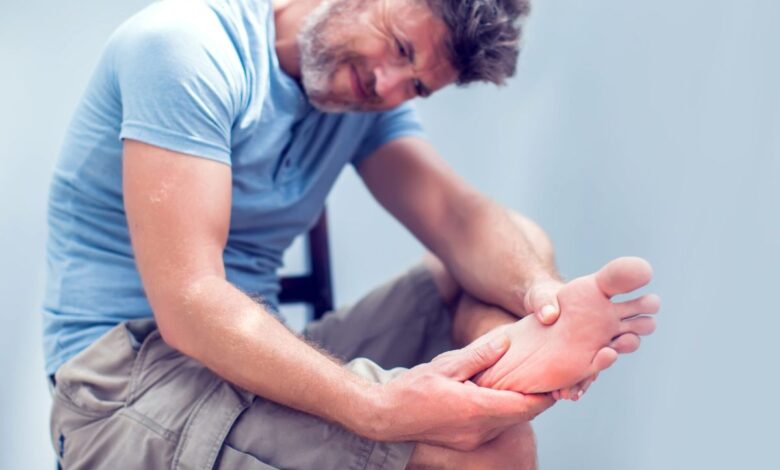Understanding the Root Causes of Heel Pain and Remedies

The calcaneus, the heel bone, is covered by a cushion of fatty tissue called the heel, which maintains its form under the force of motion & body weight. It protects the calcaneus, muscles, & ligaments, among other foot tissues. A prevalent foot condition is heel discomfort. You can even try out acupuncture for plantar fasciitis, that’s if you have this condition but remember that you should not shy away from treatments and must not let yourself suffer from such conditions.
Which Prevalent Factors Lead to Heel Pain?
Heel discomfort has some frequent reasons.
Plantar Fasciitis:
This painful and stiffening condition is brought on by excessive pressure on the plantar fascia ligament in the feet.
Sprains and Strains:
These are physical activity-related ailments that frequently affect the body. These wounds are frequent and, subject to the event, might be mild or serious.
Fracture:
A fracture is a break in the bone. It is regarded as an emergency in medicine. You might need to get urgent attention.
Achilles Tendonitis:
Overuse injuries cause the tendon which links the calf muscles to the heel to become uncomfortable or inflamed.
Bursitis:
The fluid-filled sacs called bursae are located in your joints. These encircle the points wherein muscle, tendon, & skin touch the bones.
Ankylosing Spondylitis:
Your spine is the main organ affected by this type of arthritis. It severely inflames the vertebrae, which may ultimately result in long-term discomfort & incapacity.
Osteochondroses:
In children and teenagers, these conditions have an immediate effect on bone development.
Reactive Arthritis:
This kind of arthritis is brought on by an infection inside the human body.
Signs to Look Out for
Heel discomfort is the main symptom, although it may differ in kind and degree. It usually gets worse with the first steps in the early hours or after periods of rest. It may be mild, acute, or stabbing. Additional indicators suggesting something could be wrong include warmth, redness, & swelling over the heel.
When to Consult a Physician
Seeking help from a practitioner is critical if your heel pain has not been addressed, and also within a reasonable period if taking medications hasn’t worked or if the pain becomes too excruciating for you to do your daily duties. They do this by offering more specialized care like steroid injections, physical therapy sessions, or in worst-case scenarios, might even do surgery.

Treatment:
The underlying reason for heel pain determines how the issue should be treated. Conservative measures including rest, ice, compression, and elevation (RICE) are advised in the majority of instances. Non-steroidal anti-inflammatory medicines (NSAIDs), massage, & stretching procedures are further conservative therapies that help lessen pain and inflammation.
Avoiding Heel Discomfort
Heel discomfort can be prevented by a variety of methods, such as:
- Put on shoes which fit well and have a secure closure, like laces.
- Select footwear with comfortable heels and shock-absorbing soles.
- Any shoes with damaged heels should be repaired or thrown aside.
- When working out or playing sports, properly warm up and cool down, making sure to incorporate lots of gentle, continuous stretches.
- Your podiatrist will demonstrate how to strap or tape your feet if needed to assist in strengthening the muscles and ligaments in your feet.
- Long-term foot support may be achieved by wearing orthotics (orthoses) tailored by a podiatrist.
Things to Keep in Mind
- The heel is a cushioned, fatty tissue-filled support which maintains its form under the force of movement and body weight.
- Obesity, poorly fitting shoes, running & leaping on hard surfaces, unusual walking gait patterns, traumas, and specific diseases are among the common reasons for heel discomfort.
- The inflammation of the plantar fascia, which spans the whole length of the foot, is usually brought on by overstretching. It causes soreness beneath the heel, especially when you’re not moving.
- A heel spur is a growth of bone which frequently feels painless to the touch.
- Stress on the heel bone’s development plate is the root cause of Sever’s disease.
Which Variables Put One at Risk for Heel Pain?
Heel discomfort can result from anything which puts a lot of stress and pressure on the foot. Additional aspects include your foot’s form (foot structure) & how well you walk (foot mechanics).
Heel discomfort may be more probable to occur if you:
- Possess obesity or are overweight.
- Possess high arches in their feet, flat feet, or arthritis in their ankles.
- For fitness or in sports, run or jump a lot.
- Stand for extended periods with particular emphasis on concrete floors.
- Put on ill-fitting shoes that lack a cushion or arch support.
What Side Effects Might Heel Pain Cause?
You should know that there will be some restrictions to your movements, sports, job and personal life caused by this heel pain. In other words, your attention will focus on the fact that movement only causes pain rather than recognizing that staying sedentary is affecting your health. The inability to do the beloved day-to-day life activities that you usually enjoy might be a factor that takes you toward a melancholic mood. The breakdown of the Achilles tendon (called tendinosis) is more severe than bare tendonitis if it doesn’t get treatment eventually. The Achilles tendon is susceptible to a partial or a complete rupture, as users grow old. A surgical operation may be required to solve this problem.
Final Words:
Although extremely common, heel discomfort shouldn’t be overlooked. By addressing the root causes and applying practical solutions, you may quickly restore what you normally do. Never overlook that the secret to a speedy complete recuperation is swift action.
Also, read: Create a Relaxing Bedroom









